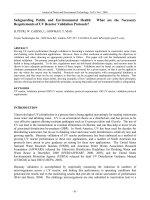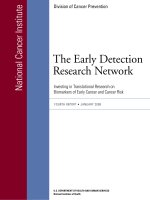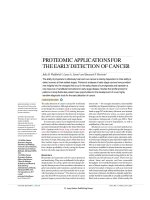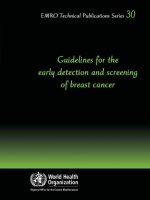Health professionals and the early detection of head and neck cancers: A population-based study in a high incidence area
Bạn đang xem bản rút gọn của tài liệu. Xem và tải ngay bản đầy đủ của tài liệu tại đây (501.22 KB, 9 trang )
Ligier et al. BMC Cancer (2016) 16:456
DOI 10.1186/s12885-016-2531-7
RESEARCH ARTICLE
Open Access
Health professionals and the early
detection of head and neck cancers: a
population-based study in a high incidence
area
Karine Ligier1*, Olivier Dejardin2, Ludivine Launay2, Emmanuel Benoit3, Emmanuel Babin2,4, Simona Bara5,
Bénédicte Lapôtre-Ledoux6, Guy Launoy2,7 and Anne-Valérie Guizard8
Abstract
Background: In the context of early detection of head and neck cancers (HNC), the aim of this study was to
describe how people sought medical consultation during the year prior to diagnosis and the impact on the stage
of the cancer.
Methods: Patients over 20 years old with a diagnosis of HNC in 2010 were included from four French cancer
registries. The medical data were matched with data regarding uptake of healthcare issued from French National
Health Insurance General Regime.
Results: In 86.0 % of cases, patients had consulted a general practitioner (GP) and 21.1 % a dentist. Consulting a GP at
least once during the year preceding diagnosis was unrelated to Charlson index, age, sex, département, quintile of
deprivation of place of residence. Patients from the ‘quite privileged’, ‘quite underprivileged’ and ‘underprivileged’
quintiles consulted a dentist more frequently than those from the ‘very underprivileged’ quintile (p = 0.007).
The stage was less advanced for patients who had consulted a GP (OR = 0.42 [0.18–0.99]) - with a dose–response effect.
Conclusions: In view of the frequency of consultations, the existence of a significant association between consultations
and a localised stage at diagnosis and the absence of a socio-economic association, early detection of HNC by GPs would
seem to be the most appropriate way.
Keywords: Early detection, Head and neck cancers, Cancers registry, Socio-economic factors, Stage at diagnosis, Uptake
of healthcare, Health insurance, Epidemiology
Background
In Europe, head and neck cancers (HNC) are the forth
most common group of cancers among men with an estimated annual incidence of 109 900 cases and 52 300
deaths [1]. Among women these cancers are less common. France, especially in the north-west [2, 3], has an
incidence rate amongst the highest in Europe [1],
although it is constantly decreasing [4]. In France in
2012, the world standardised incidence rate of cancers
situated in the lips, mouth and pharynx was 16.1 cases
per 100 000 person-years (p-y) for men and 5.6 cases
* Correspondence:
1
General Cancer Registry of Lille and its area, GCS-C2RC, F-59037 Lille, France
Full list of author information is available at the end of the article
per 100 000 p-y for women. For the larynx, rates were
5.4 and 0.9 cases per 100 000 p-y respectively for men
and women.
The main risk factors are tobacco and alcohol. Other
risk factors have been identified or are suspected, including Human Papilloma Virus infection, a diet lacking in
fruit and vegetables, exposure to carcinogens in some
work environments, teeth in poor condition or Human
Immunodeficiency Virus infection [5]. In addition, these
cancers are strongly linked to socio-economic factors:
there are more deaths from HNC in people with a lower
level of education compared with people with a higher
level [6]. The risk of developing one of the HNC is
greater in those with low incomes, with a low level of
© 2016 The Author(s). Open Access This article is distributed under the terms of the Creative Commons Attribution 4.0
International License ( which permits unrestricted use, distribution, and
reproduction in any medium, provided you give appropriate credit to the original author(s) and the source, provide a link to
the Creative Commons license, and indicate if changes were made. The Creative Commons Public Domain Dedication waiver
( applies to the data made available in this article, unless otherwise stated.
Ligier et al. BMC Cancer (2016) 16:456
education, or belonging to a poorer socio-professional
category [7]. These social differences persist even after
adjustment for tobacco and alcohol consumption and
for dietary factors [8].
Only in 30 % of cases, HNC are diagnosed at a localised
stage [9, 10]. Late diagnosis is associated with a lower survival rate : 5-year survival in patients diagnosed at an advanced stage is reduced by a factor of 2 to 4 compared with
that for patients diagnosed at a localised stage [9–11].
Also, time from symptom onset to treatment can be
long. A recent review showed that the patient delay varied
from 3.5 to 5.4 months and professional delay from 14 to
21 weeks [12]. Professional delay depends essentially on
multi-disciplinary patient management (oral rehabilitation,
refeeding, etc.), and healthcare delivery factors. Some
studies showed that these delays lead to tumour growth
[13, 14], advanced stage [15], or even an increased risk of
death for the patient [16].
The prognosis is therefore extremely poor, with a net
5-year survival of only 32 % in France [17]. This figure is
considerably lower than that in other European countries [18] and has hardly improved over the last 15 years.
On top of this, aggressive treatment regimes following
late diagnosis can lead to serious sequels that affect
quality of life, notably through changes in phonation,
respiration, nutrition and physical appearance [19].
In view of this, screening programmes or early diagnosis
of these cancers should be a pressing concern in public
health, particularly for oral cavity lesions, which are easily
accessible on clinical examination. The last review of the
literature by the Cochrane group highlighted the lack of
studies that would enable an assessment of the efficacy
and cost of a screening programme for oral cavity cancers
[20]. However, it also recommended ‘opportunistic visual
screening by trained dentist and oral health practitioners’,
especially for smokers and patients who drink alcohol.
The French governmental cancer plan 2009–2013 [21]
advocated early detection of oral cavity cancers. Following
this, in spite of the absence of any scientific proof, probably
to demonstrate a pro-active attitude, the National Cancer
Institute (INCa) set up multimedia training for dentist
(2009) and general practitioners (2010) to teach them how
to detect suspicious lesions through an in-depth examination of the oral cavity in high-risk patients [22].
Few works have studied the health habits prior to
HNC diagnosis among these patients. A study among
HNC patients in a Medicare population showed that
about 90 % had had at least one visit to a physician in
the year prior to diagnosis [23]. Another study showed
that 82 % of HNC patients had first visited a general
practitioner and 12 % a dentist (Tromp [24]). In France,
health habits prior to HNC diagnosis are unknown
among these patients who are often in a socially fragile
position linked to their addiction to tobacco and alcohol.
Page 2 of 9
The aim of this study was to describe how people
sought medical consultation during the year prior to
HNC diagnosis and the impact of these consultations on
the stage of the cancer at diagnosis.
Methods
Study population
Included in the study were patients over 20 years old,
covered by the French National Health Insurance General
Regime, with a diagnosis of epithelial infiltrating HNC
reported between 1 January 2010 and 31 December
2010 (N = 342, Table 1). Head and neck cancer cases
were comprised of the anatomic sites oral cavity, oropharynx, hypopharynx and larynx (International Classification of Diseases for Oncology, 3rd edition - ICD-O 3
codes : C01-C06, C09-C10,C12-C14 and C32).
The patients were taken from the cancer registries of
the Calvados, Manche and Somme départements and
the area around Lille (ZPL). These registries meet highquality criteria : the completeness and data quality are
regularly assessed by the Comité National des Registres.
Patients with a prior invasive or in situ cancer (excepting
basal-cell and squamous-cell skin tumours) were excluded
from the study.
Medical data
As part of a high resolution study, data were extracted
from the medical files and included the patient’s date of
birth, gender, address, comorbidities, date of diagnosis,
the topography and morphology of the cancer according
to the ICD-O 3, the clinical stage of the tumour at diagnosis (TNM stage from the International Union Against
Cancer’s TNM Classification of malignant tumors, 7th
edition) and the existence of a synchronous HNC (within
a 6-month period).
Comorbidities were classified using the Charlson comorbidity index [25]. Patients were divided into 3 groups for
comorbidity: 0 (no comorbidity), 1–2 (moderate comorbidity), 3 and over (severe comorbidity).
Data regarding uptake of healthcare
For patients included in the study, data concerning healthcare uptake were supplied by the general regime of the national health insurance (ERASME database –Extraction,
Research, Analysis and Medico-Economic monitoring)
which covers 88 % of the French population [26]. Data extracted included dates of consultation and the speciality of
the medical practitioner consulted. They also concerned
the date of declaration of the referring doctor. Since 2004,
each patient has to declare a referring doctor for the reimbursement of care in France. The referring doctor, usually
a general practitioner, is the first medical practitioner contacted by the patient. He regulates access to specialist.
Ligier et al. BMC Cancer (2016) 16:456
Page 3 of 9
Table 1 Patient and tumour characteristics and univariate analysis of tumour stage at diagnosis
Stage I-IIa
N
Stage III-IVa
%
N
p univariate
%
Sex
Total
N
%
0.209
Male
75
27.5
198
72.5
278
81.3
Female
22
35.5
40
64.5
64
18.7
< 55 years
32
27.6
84
72.4
119
34.8
55–65 years
33
25.4
97
74.6
130
38.0
> =65 years
32
36.0
57
64.0
93
27.2
14
35.0
26
65.0
41
12.0
Age at diagnosis
0.220
Charlson Index
0.290
0
1 to 2
42
25.1
125
74.9
169
49.4
3 and over
41
32.0
87
68.0
132
38.6
16
23.5
52
76.5
69
20.2
Manche
15
31.3
33
68.8
48
14.0
ZPL
43
32.6
89
67.4
135
39.5
Somme
23
26.4
64
73.6
90
26.3
0.531
Département
Calvados
Tumour site
<0.001
Oral cavity
44
36.7
76
63.3
124
36.3
Oropharynx
13
15.3
72
84.7
85
24.8
Hypopharynx
4
6.5
58
93.5
63
18.4
Larynx
36
52.9
32
47.1
70
20.5
14
32.6
29
67.4
43
12.6
b
Deprivation quintile
Privileged 1
0.065
Quite privileged 2
11
23.9
35
76.1
47
13.8
Quite underprivileged 3
18
47.4
20
52.6
40
11.8
Underprivileged 4
22
30.6
50
69.4
74
21.8
Very underprivileged 5
32
23.9
102
76.1
136
40.0
No
9
19.1
38
80.9
48
14.0
Yes
88
30.6
200
69.4
294
86.0
GP consultation
0.110
GP consultation (in 3 categories)
0.071
No consultation
9
19.1
38
80.9
48
14.0
1 to 2 consultations
14
22.2
49
77.8
64
18.7
> =3 consultations
74
32.9
151
67.1
230
67.3
Dentist consultation
0.029
No
70
26.2
197
73.8
270
79.9
Yes
27
39.7
41
60.3
72
21.1
No
45
25.4
132
74.6
181
52.9
Yes
52
32.9
106
67.1
161
47.1
Specialist consultation, non-ENT
0.131
ENT specialist consultation
0.002
No
71
25.4
208
74.6
286
83.6
Yes
26
46.4
30
53.6
56
16.4
Ligier et al. BMC Cancer (2016) 16:456
Page 4 of 9
Table 1 Patient and tumour characteristics and univariate analysis of tumour stage at diagnosis (Continued)
Nurse consultation
0.646
No
54
27.0
139
73.0
195
57.0
Yes
43
30.3
99
69.7
147
43.0
a
for seven patients stage at diagnosis was unknown
for two patients the quintile of deprivation was unknown
Abbreviations: ZPL area around Lille, GP general practitioner, ENT ear, nose and throat
b
Patients who had declared a referring doctor in the
2 months preceding diagnosis or after diagnosis were
considered to have no referring doctor before diagnosis.
Only consultations between 2 and 12 months before
cancer diagnosis were taken into account. The codes of
health professionals who had carried out consultations
or procedures were categorised into the following
groups: general practitioner (GP), dentist, Ear, Nose and
Throat specialist (ENT specialist) and other specialist
(non - ENT specialist) nurse.
Socio-economic data
As there is no individual socio-economic data in the
medical records, the socio-economic status of patients
was evaluated by measuring that of their place of residence using a social deprivation index. The index used
was the EDI [27]. This is based on both individual data
from the European Union Statistics on Income and Living Conditions (EU-SILC) survey and aggregated data
(at the IRIS level - Ilots Regroupés pour l'Information
Statistique–, which is the smallest geographical unit for
which figures are available) from the 2007 French national census carried out by INSEE, the national institute
for statistics and economic studies. The IRIS for each
patient was determined by the home address at the time
the HNC diagnosis was made.
In our statistical analyses, we used the national quintile
of this index.
Data analysis
We tested for associations between qualitative variables
using the chi-square test or Fisher’s exact test. Quantitative variables were described by median and 25th and
75th percentiles (Q1-Q3). In order to determine factors
influencing the probability of seeking healthcare or factors leading to diagnosis at an advanced tumour stage
(stage I – II vs III – IV), logistic regressions were used.
Regarding the influence of a consultation with each type
of health professional on tumour stage at diagnosis, multivariable models were used. Odds ratios (OR) were presented with their 95 % confidence intervals (CI 95 %).
The models took into account only observations with
no missing values for the different variables studied
(‘complete case analysis’).
Analysis was performed using StataIC 11 software
(StataCorp. 2011. Stata: Release 11. Statistical Software.
College Station, TX: StataCorp LP).
Results
Uptake of healthcare
Of the 342 patients with HNC, 92.7 % had declared a referring doctor before cancer diagnosis. During the year
preceding diagnosis, patients had consulted a health professional at least once in 87.7 % of cases and at least
three times in 75.7 % of cases.
In 86.0 % of cases, patients had consulted a GP (Table 1).
Amongst patients having consulted a GP, the median
number of consultations was 5 [Q1 :3; Q3 :11]. As regards
other health professionals, 21.1 % of patients had consulted a dentist, 47.1 % a non-ENT specialist, 16.4 % an
ENT specialist and 43.0 % a nurse. The most consulted
specialists outside of ENT were ophthalmologists (25.1 %)
and specialists in cardiovascular pathology (14.0 %).
In the multivariable analysis (Table 2), consulting a GP
at least once during the year preceding diagnosis was
unrelated to Charlson index, age, sex, département,
quintile of deprivation of place of residence. Consulting
a dentist or a non-ENT medical specialist at least once
during the year before diagnosis was associated with the
deprivation quintile. Patients from the ‘quite privileged’,
‘quite underprivileged’ and ‘underprivileged’ quintiles
consulted a dentist more frequently than those from the
‘very underprivileged’ quintile (p = 0.007). Patients from
the ‘privileged’ quintile consulted a non-ENT specialist
more frequently than those from the ‘very underprivileged’ quintile (p = 0.003). More frequent nurse visits
were linked with the presence of 3 or more comorbidities (p = 0.011). Interactions between sex and age, and
age and deprivation quintile were tested; they were not
significant.
Factors influencing stage at diagnosis
In univariate analysis (Table 1), a localised stage at diagnosis was more frequently associated with cancers of the
oral cavity and larynx (p < 0.001), in patients consulting
a dentist (p = 0.029) or an ENT specialist (p = 0.002) during the year prior to diagnosis.
Multivariable analysis of staging showed no association
with sex, age at diagnosis, the Charlson index, the
département or the deprivation quintile. Only tumour
General practitioner
OR
CI 95 %
Sex
Dentist
p
OR
Non-ENT specialist
CI 95 %
0.827
Male
1.00
Female
1.09
p
Age at diagnosis
CI 95 %
0.846
1.00
0.47–2.55
OR
0.93
ENT specialist
p
0.162
1.11
Nurse
p
1.54
CI 95 %
1.08
0.59–1.97
0.739
1.00
55–65 years
0.43
0.17–1.10
0.43
0.21–0.89
1.01
0.55–1.87
0.75
0.34–1.67
1.26
0.68–2.36
> =65 years
0.72
0.22–2.35
0.52
0.21–1.28
2.07
0.96–4.45
0.96
0.35–2.67
1.56
0.73–3.36
0.285
1.00
0.520
< 55 years
Charlson index
0.739
1.00
1.00
0.712
1.00
0.770
1.00
1 to 2
2.12
0.69–6.54
1.08
0.43–2.69
1.21
0.54–2.75
0.95
0.35–2.57
1.87
0.74–4.74
3 and over
2.99
0.77–11.60
0.81
0.27–2.45
1.47
0.56–3.84
0.70
0.20–2.44
4.06
1.41–11.7
0.249
1.00
0.011
0
Département
0.109
1.00
1.00
0.769
0.701
1.00
Manche
1.39
0.51–3.74
0.81
0.30–2.15
0.95
0.43–2.09
1.15
0.43–3.11
1.16
0.52–2.59
ZPL
2.36
1.00–5.56
1.98
0.91–4.28
1.30
0.68–2.46
0.88
0.37–2.08
1.27
0.66–2.46
Somme
1.87
0.78–4.51
1.00
0.43–2.34
1.26
0.64–2.49
1.39
0.58–3.29
1.94
0.97–3.87
0.784
1.00
0.261
Calvados
Deprivation quintile
1.00
0.007
1.00
0.003
0.283
0.251
Privileged 1
1.41
0.47–4.20
1.67
0.64–4.31
3.70
1.67–8.18
1.22
0.46–3.22
1.95
0.92–4.12
Quite privileged 2
1.39
0.49–3.95
3.21
1.33–7.78
1.33
0.66–2.71
1.54
0.61–3.87
2.04
0.98–4.22
Quite underprivileged 3
0.70
0.27–1.83
3.14
1.25–7.89
0.71
0.34–1.52
0.32
0.07–1.48
1.45
0.67–3.12
Underprivileged 4
1.12
0.47–2.69
3.73
1.76–7.90
0.75
0.40–1.38
1.60
0.74–3.46
1.27
0.68–2.38
Very underprivileged 5
1.00
1.00
1.00
1.00
p
0.799
1.00
0.76–3.11
0.081
1.00
OR
0.232
1.00
0.62–1.98
0.070
1.00
CI 95 %
0.735
1.00
0.46–1.89
OR
Ligier et al. BMC Cancer (2016) 16:456
Table 2 Multivariable analysis of healthcare uptake (N = 340)
1.00
Abbreviations: OR odds ratio, CI confidence interval, ZPL area around Lille, ENT ear, nose and throat
Page 5 of 9
Ligier et al. BMC Cancer (2016) 16:456
site was significantly associated with stage (p < 0.001)
(result not shown).
After adjustment for these variables, the stage was
less advanced for patients who had consulted a GP
(OR = 0.42 [0.18–0.99]) - with a dose–response effect
when the number of consultations with the GP was divided into 3 categories (p = 0.022) - and also in those who
had consulted an ENT specialist (OR = 0.31 [0.15–0.62])
(Fig. 1). For oral cavity cancers, seeing a dentist was not
associated with stage at diagnosis (results not shown).
Discussion
This study shows that patients developing HNC live in an
underprivileged social environment in nearly two thirds of
cases but that they are not excluded from the health system.
Indeed, the vast majority of patients declared a referring
doctor and consulted a GP during the year preceding their
diagnosis, these consultations being regular in two thirds of
patients. In addition, the act of seeking a GP consultation in
this population is not socially determined and is associated
with a diagnosis of localised cancer. As regards consultations
with a dentist, this is rather infrequent, and the lower the
socio-economic level of the place of residence is, the lower
the rate of consultation is. There is no association between
dentist consultation and a diagnosis of localised cancer.
Page 6 of 9
With the exception of dysphonia in cancers of the
larynx, most symptoms of HNC are non-specific but
should be a cause for concern in patients with a high
consumption of alcohol and tobacco. Each and every
contact with a health professional should be an opportunity
to make an early diagnosis of HNC and such opportunities
are far from rare because in our study, 87.7 % of patients
consulted a health professional at least once during the year
prior to their diagnosis. This figure is close to that of Reid’s
study [23].
A localised stage at diagnosis was related to consultation
with a GP, with a dose–response effect according to the
number of consultations. This dose–response effect suggests that medical monitoring has an impact on the stage
at diagnosis. A similar result was found in a study carried
out by Reid et al [28], on consultations with hospital physicians. This result needs to be considered in parallel with
the fact that visits to the GP are frequent during the year
prior to diagnosis. There is therefore a real potential for
early diagnosis of these cancers by GPs in a target population, which remains to be defined.
Moreover, our results show that GP consultations are
not linked to the deprivation index. This is all the more
important considering that two thirds of the population
studied live in underprivileged areas. In France, a country
Fig. 1 Factors associated with an advanced stage at diagnosis – multivariable analysisa. a. After adjustment for sex, age, Charlson index, department,
tumour site and deprivation quintile. Abbreviation : OR = odds ratio,LCI = lower confidence interval, UCI = upper confidence interval, GP = general
practitioner, ENT = ear, nose and throat
Ligier et al. BMC Cancer (2016) 16:456
with universal healthcare coverage, patient payments for
GP consultation are conjointly reimbursed by social insurance (roughly 70 %) and by complementary health insurance plans (around 30 %) if patients can afford them.
Deprived patients are fully reimbursed by social insurance.
Our results are thus generalizable only with countries with
comparable health care organization. However, our results
are consistent with other European studies showing that
GP consultations, unlike specialist consultations, are not
dependent on the socio-economic level [29].
In France, Dentists examine around 500 000 mouths a
day [22]; initially, it would thus seem an obvious strategy
to entrust early detection of oral cavity cancers to these
health professionals. However, our study shows that the
population of patients who developed HNC rarely visit
the dentist (21.1 %). Coupled with this, dental consultations are socially determined : people living in the most
affluent areas and those living in the most deprived areas
consulted dentists least in the year preceding diagnosis.
In the first case, we can hypothesise that the low rate of
consultation is linked to generally good dental health requiring little care. In the second case, lack of access to
dental care because of financial restraints might be suspected: in France, the most underprivileged patients
forgo dental care 10.5 times more often than people who
are not in a socially precarious position [30], and where
dental care is not taken up, 49.9 % put forward financial
reasons [31]. This lack of uptake is even more significant
as 40.0 % of the population studied lived in the most deprived areas. What is more, our results show that HNC
stage at diagnosis, particularly in the oral cavity, was not
associated with dentist consultation in the year before
diagnosis. Given that raising the awareness of these
health professionals about early diagnosis of oral cavity
cancers started only at the end of 2008, it may be that
we have not yet had enough time to detect an effect.
Altogether, in the absence of any scientific demonstration
of a positive effect on the mortality rate, the pragmatic national policies on an HNC screening programme, based
on dentists for early detection of oral lesions, risk having a
deleterious effect on social inequalities in health care.
Finally, the association between a localised stage at
diagnosis and consultation with an ENT specialist does
not reflect the practice of early diagnosis of these cancers in the general population. It may be interpreted as
the follow-up of various pathologies such as leucoplakia,
erythroplakia or dysplastic lesions of the oral cavity and
vocal cords, which can subsequently degenerate [32, 33].
The main strength of this study resides in the crossanalysis of data taken from cancer registries situated in
high incidence areas and that from the national health insurance system. The study design was based on the
method of ‘high-resolution population-based study’: data
was collected in a precise and rigorous manner from the
Page 7 of 9
medical files in order to know all the characteristics of the
cancer cases included. The inclusion of patients from the
cancer registries allowed us to overcome the recruitment
bias of hospital studies and give information on the totality of cancer cases in a given geographic area. Data taken
from the national health insurance enabled us to identify
all the health professionals consulted. This cross-analysis
of nominative databases between the registries and the
national health insurance is unusual because they do not
operate on the same time frame. The cross-analysis of
databases was carried out in January 2011 with the health
insurance data which covered the period from 01.01.2009
to 31.12.2010 (data regarding utilization of healthcare are
conserved for only two years). Thus, it was possible to
have one full year of healthcare utilization data prior to
diagnosis only for patients diagnosed in 2010. It was thus
not possible to carry out a retrospective data collection regarding this uptake. Within the framework of this study,
the registries tracked cases prospectively and validated
HNC in priority in order to make the two time frames
coincide.
Since information on the socioeconomic status of individuals is not available in cancer registries in France, the
use of the deprivation index (EDI) is a pragmatic solution. Indeed, it is commonly argued that using area-level
data is a valid and useful approach for circumventing the
lack of individual information in medical files [33].
The main limit of our study is the small patient number,
which precluded the possibility of completing a detailed
topographical analysis of the tumours. It is true that our
study covers the whole group of HNC whilst the recommendations for early diagnosis target oral cavity cancers
only. Nevertheless, habits of medical care uptake concern
the same at-risk population. The small number of patients
limits the scope of our study. However, the study provides
information on how patients recruited from four different
cancer registries in a high-incidence area take up medical
care. Lastly, data regarding uptake of healthcare are only
available on patients registered under the general regime of
the national insurance service but this covers 88 % of the
French population [26]. Moreover, the patients unregistered
(12 %) are affiliated to other public regimes. They have the
same access to medical services and receive the same reimbursement rate than patients recorded to the general regime of the national insurance service. However, we don’t
know the socio-economic status of this population.
The aim of this work was to describe patient habits in
respect of utilization of medical services; it was therefore
necessary to analyse only utilization before cancer diagnosis. However, as it was impossible to trace the specific
medical consultation that began the cancer management,
only medical services taken up between 12 months and
2 months before histological diagnosis of the cancer
were taken into account.
Ligier et al. BMC Cancer (2016) 16:456
Conclusions
In view of the frequency of GP consultations, the existence
of a significant association between GP consultations and
a localised stage at diagnosis and the absence of a socioeconomic aspect to this mode of medical services uptake,
early detection of HNC by GPs would seem to be the
most appropriate way. To this end, high-quality professional training for GPs is necessary. Nevertheless, the
benefit of such early detection on the mortality rate of
HNC remains to be shown and the target population must
be defined.
Abbreviations
ENT, Ear, Nose and Throat; ERASME, Extraction Research Analysis and MedicoEconomic monitoring database; GP, general practitioner; HNC, head and neck
cancers; ICD-O 3, International Classification of Diseases for Oncology, 3rd edition;
IRIS, Ilots Regroupés pour l’Information Statistique; OR, Odds ratios; CI, Confidence
Interval; Q1, 25th percentile; Q3: 75th percentile; ZPL, area around Lille
Acknowledgement
We thank the ENT specialists, maxillofacial surgeons, oncologists,
pathologists, the doctors of the health insurance funds and patient
administrative database, the multidisciplinary committees, the medical
secretaries and archivists of Calvados, Manche, Nord and Somme. We thank
Mrs Gillian Cadier for the translation of the manuscript.
Funding
We thank the French National Cancer Institute, which provided financial
support for this study.
Competing interests
The authors declare that they have no competing interest.
Availability of data and materials
The database used in this study can be requested from the scientific committee
of the study via the first author of this manuscript. Confidentiality of the data
collected is protected in accordance with the French regulations and policies.
Authors’ contributions
KL conceived and coordinated the study, coordinated the insurance and medical
data collection and performed the statistical analysis. AVG co-coordinated medical
data collection. GL conceived and co-coordinated the study. OD and LL
participated in the statistical analysis. SB and BLL collected medical data. EBenoit
collected data regarding utilization of healthcare. LL collected socioeconomic
data. EBabin reviewed medical data. All authors participated in the conception
of the study, the interpretation of data and have read and approved the final
manuscript. All authors agree to be accountable for all aspects of the work in
ensuring that questions related to the accuracy or integrity of any part of the
work are appropriately investigated and resolved.
Consent for publication
Not applicable.
Ethics approval and consent to participate
The study was authorised by the CNIL (the French national data protection
agency) - n°907276 and n°910461.
Author details
1
General Cancer Registry of Lille and its area, GCS-C2RC, F-59037 Lille, France.
2
University Hospital of Caen, U1086 INSERM UCBN “Cancers & preventions”,
F-14000 Caen, France. 3ERSM-Nord, F-59665 Villeneuve d’Ascq, France.
4
Department of Otorhinolaryngology and Cervicofacial Surgery, University
Hospital of Caen, F-14000 Caen, France. 5General Cancer Registry of Manche,
Centre Hospitalier Public du Cotentin, F-50100 Cherbourg-Octeville, France.
6
General Cancer Registry of Somme, Hôpital Nord, F-80054 Amiens, France.
7
Pôle de Recherche, Centre Hospitalo-Universitaire de Caen, F-14000 Caen,
France. 8General Cancer Registry of Calvados, U1086 INSERM UCBN “Cancers
et preventions”, Centre F Baclesse, F-14000 Caen, France.
Page 8 of 9
Received: 15 September 2015 Accepted: 6 July 2016
References
1. Ferlay J, Steliarova-Foucher E, Lortet-Tieulent J, Rosso S, Coebergh JW,
Comber H, Forman D, Bray F. Cancer incidence and mortality patterns in
Europe: estimates for 40 countries in 2012. Eur J Cancer. 2013;49(6):1374–403.
2. Ligier K, Belot A, Launoy G, Velten M, Bossard N, Iwaz J, Righini CA,
Delafosse P, Guizard AV, network F. Descriptive epidemiology of upper
aerodigestive tract cancers in France: incidence over 1980-2005 and
projection to 2010. Oral Oncol. 2011;47(4):302–7.
3. Ligier K, Plouvier S, Danzon A, Martin P, Benoit E, Molinie F, Launoy G,
Buisset E, Leroy X, Chevalier D, et al. Elements of completeness and results
of the first year of registration of the “Registre general des cancers de Lille
et de sa region”. Rev Epidemiol Sante Publique. 2012;60(2):131–9.
4. Binder-Foucard F, Belot A, Delafosse P, Remontet L, Woronoff AS, Bossard N:
Estimation nationale de l’incidence et de la mortalité par cancer en France
entre 1980 et 2012. Partie 1 – Tumeurs solides. Saint-Maurice Institut de veille
sanitaire; 2013. http://wwwinvssantefr/Publications-et-outils/Rapports-etsyntheses/Maladies-chroniques-et-traumatismes/2013/Estimation-nationale-del-incidence-et-de-la-mortalite-par-cancer-en-France-entre-1980-et-2012.
Accessed 6 June 2016.
5. Righini CA, Karkas A, Morel N, Soriano E, Reyt E. Risk factors for cancers of the oral
cavity, pharynx (cavity excluded) and larynx. Presse Med. 2008;37(9):1229–40.
6. Menvielle G, Kunst AE, Stirbu I, Strand BH, Borrell C, Regidor E, Leclerc A,
Esnaola S, Bopp M, Lundberg O, et al. Educational differences in cancer
mortality among women and men: a gender pattern that differs across
Europe. Br J Cancer. 2008;98(5):1012–9.
7. Conway DI, Petticrew M, Marlborough H, Berthiller J, Hashibe M,
Macpherson LM. Socioeconomic inequalities and oral cancer risk: a
systematic review and meta-analysis of case-control studies. Int J Cancer.
2008;122(12):2811–9.
8. Conway DI, Brenner DR, McMahon AD, Macpherson LM, Agudo A, Ahrens
W, Bosetti C, Brenner H, Castellsague X, Chen C, et al. Estimating and
explaining the effect of education and income on head and neck cancer
risk: INHANCE consortium pooled analysis of 31 case-control studies from
27 countries. Int J Cancer. 2015;136(5):1125–39.
9. Pulte D, Brenner H. Changes in survival in head and neck cancers in the late
20th and early 21st century: a period analysis. Oncologist. 2010;15(9):994–1001.
10. Saba NF, Goodman M, Ward K, Flowers C, Ramalingam S, Owonikoko T,
Chen A, Grist W, Wadsworth T, Beitler JJ, et al. Gender and ethnic disparities
in incidence and survival of squamous cell carcinoma of the oral tongue,
base of tongue, and tonsils: a surveillance, epidemiology and end results
program-based analysis. Oncology. 2011;81(1):12–20.
11. Cancer registry of Norway. Cancer in Norway 2009. Cancer incidence,
mortality, survival and prevalence in Norway. Oslo: Cancer registry of
Norway; 2011.
12. Stefanuto P, Doucet JC, Robertson C. Delays in treatment of oral cancer: a
review of the current literature. Oral Surg Oral Med Oral Pathol Oral Radiol.
2014;117(4):424–9.
13. Jensen AR, Nellemann HM, Overgaard J. Tumor progression in waiting time
for radiotherapy in head and neck cancer. Radiother Oncol. 2007;84(1):5–10.
14. Waaijer A, Terhaard CH, Dehnad H, Hordijk GJ, van Leeuwen MS,
Raaymakers CP, Lagendijk JJ. Waiting times for radiotherapy: consequences
of volume increase for the TCP in oropharyngeal carcinoma. Radiother
Oncol. 2003;66(3):271–6.
15. Neal RD, Tharmanathan P, France B, Din NU, Cotton S, Fallon-Ferguson J,
Hamilton W, Hendry A, Hendry M, Lewis R, et al. Is increased time to
diagnosis and treatment in symptomatic cancer associated with poorer
outcomes? Systematic review. Br J Cancer. 2015;112 Suppl 1:S92–S107.
16. Chen Z, King W, Pearcey R, Kerba M, Mackillop WJ. The relationship
between waiting time for radiotherapy and clinical outcomes: a systematic
review of the literature. Radiother Oncol. 2008;87(1):3–16.
17. Grosclaude P, Remontet L, Belot A, Danzon A, Rasamimanana Cerf N,
Bossard N: Survie des personnes atteintes de cancer en France. 1989-2007 Etude à partir des registres des cancers du réseau Francim. Saint-Maurice
Institut de veille sanitaire; 2013.
18. Zigon G, Berrino F, Gatta G, Sanchez MJ, van Dijk B, Van Eycken E, Francisci
S, Group EW. Prognoses for head and neck cancers in Europe diagnosed in
1995-1999: a population-based study. Ann Onco. 2011;22(1):165–74.
Ligier et al. BMC Cancer (2016) 16:456
Page 9 of 9
19. Babin E, Sigston E, Hitier M, Dehesdin D, Marie JP, Choussy O. Quality of life
in head and neck cancers patients: predictive factors, functional and
psychosocial outcome. Eur Arch Otorhinolaryngol. 2008;265(3):265–70.
20. Brocklehurst P, Kujan O, O’Malley LA, Ogden G, Shepherd S, Glenny AM.
Screening programmes for the early detection and prevention of oral
cancer. Cochrane Database Syst Rev. 2013;11:CD004150.
21. Ministère des Affaires sociales de la Santé et des Droits des femmes. Plan
cancer 2009-2013 [ Accessed 6 June 2016.
22. InCA. Détection précoce des cancers de la cavité buccale. 2008. [http://
www.e-cancer.fr/Professionnels-de-sante/Depistage-et-detection-precoce/
Detection-precoce-des-cancers-de-la-cavite-buccale/Modules-de-formationmultimedia]. Accessed 6 June 2016.
23. Reid BC, Warren JL, Rozier G. Comorbidity and early diagnosis of head and
neck cancer in a Medicare population. Am J Prev Med. 2004;27(5):373–8.
24. Tromp DM, Brouha XD, Hordijk GJ, Winnubst JA, de Leeuw JR. Patient
factors associated with delay in primary care among patients with head and
neck carcinoma: a case-series analysis. Fam Pract. 2005;22(5):554–9.
25. Charlson ME, Pompei P, Ales KL, MacKenzie CR. A new method of classifying
prognostic comorbidity in longitudinal studies: development and validation.
J Chronic Dis. 1987;40(5):373–83.
26. Sécurité sociale. Chiffres-clés 2011 de la branche maladie du régime
général.2012. [ Accessed 6 June 2016.
27. Pornet C, Delpierre C, Dejardin O, Grosclaude P, Launay L, Guittet L, Lang T,
Launoy G. Construction of an adaptable European transnational ecological
deprivation index: the French version. J Epidemiol Community Health. 2012;
66(11):982–9.
28. Reid BC, Rozier RG. Continuity of care and early diagnosis of head and neck
cancer. Oral Oncol. 2006;42(5):510–6.
29. Jusot F. Inequalities in access to care and their evolution: a review. Rev
Epidemiol Sante Publique. 2013;61 Suppl 3:S163–9.
30. Dourgnon P, Desprès C, Jusot F, Fantin R. Les comptes de la santé 2010.
Série Statistiques – Document de travail de la Drees 2011; 161: 85-96
31. Chaupain-Guillot S, Guillot O, Jankeliowitch-Laval E. Le renoncement aux
soins médicaux et dentaires : une analyse à partir des données de l'enquête
SRCV. In: Economie et Statistique 2014. />ES469H.pdf. Accessed 6 June 2016.
32. Dionne KR, Warnakulasuriya S, Zain RB, Cheong SC. Potentially malignant
disorders of the oral cavity: current practice and future directions in the
clinic and laboratory. Int J Cancer. 2015;136(3):503–15.
33. Eversole LR. Dysplasia of the upper aerodigestive tract squamous
epithelium. Head Neck Pathol. 2009;3(1):63–8.
Submit your next manuscript to BioMed Central
and we will help you at every step:
• We accept pre-submission inquiries
• Our selector tool helps you to find the most relevant journal
• We provide round the clock customer support
• Convenient online submission
• Thorough peer review
• Inclusion in PubMed and all major indexing services
• Maximum visibility for your research
Submit your manuscript at
www.biomedcentral.com/submit









